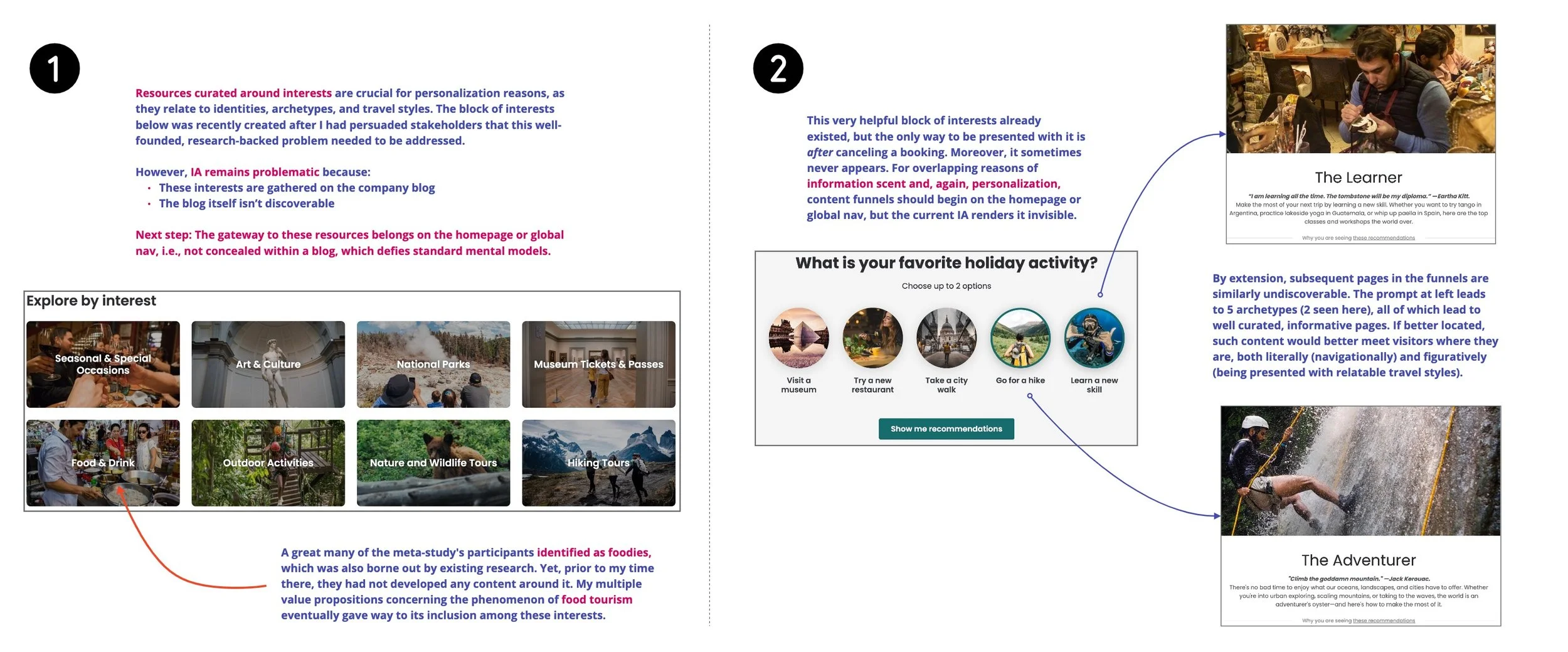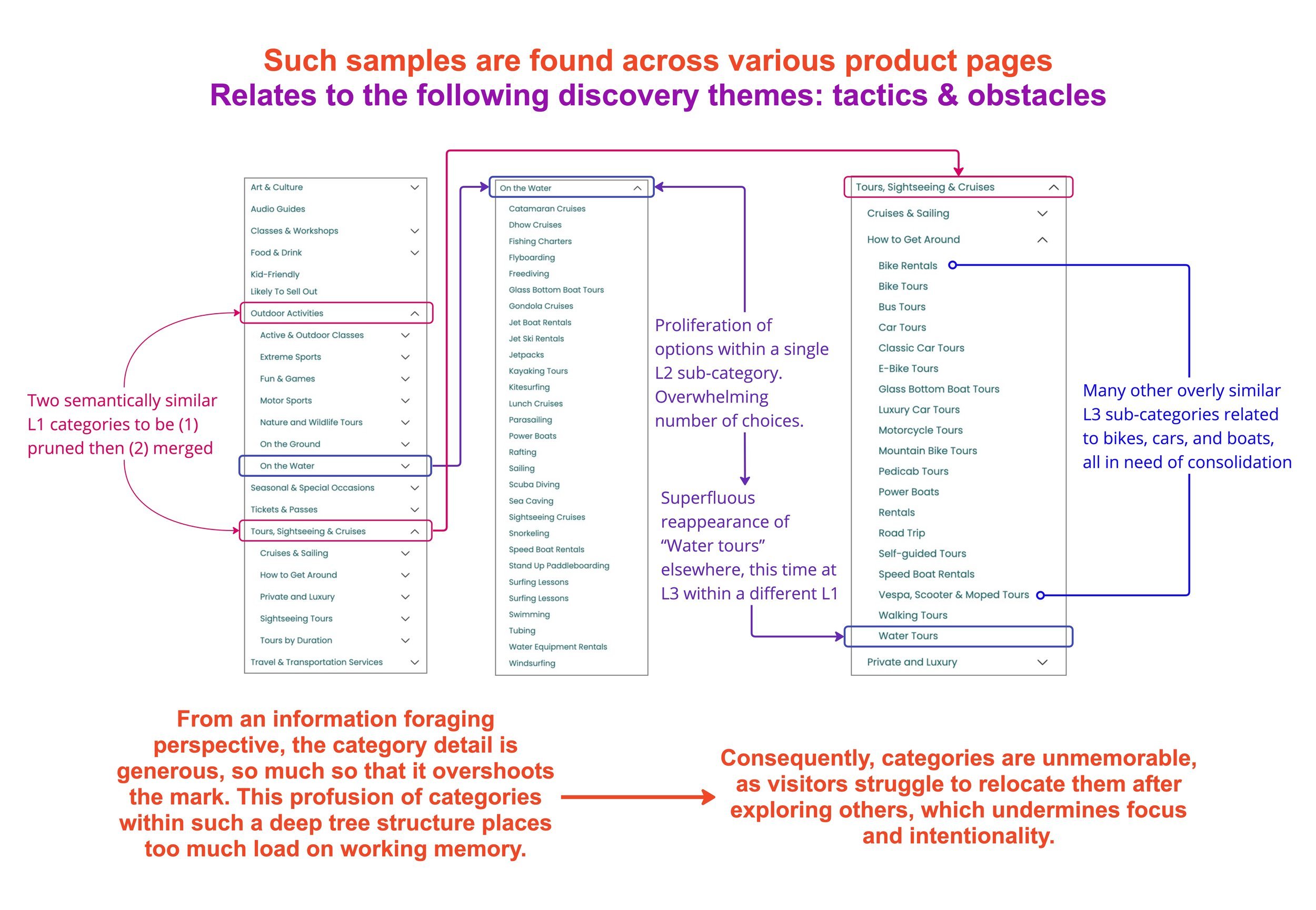How to reduce marketing costs by creating a more targeted SEO/SEM strategy through research
What motivates people to travel? Which information sources do they trust? Which devices do they prefer? What kinds of emotional bonds are formed?
“Bloggers are the new travel mentors”
On behalf of one of the world’s largest travel excursion sites, I conducted a meta-study of primary research to systematically assess such research questions in an effort to make the site stickier. The effort revealed opportunities that speak to how the company can alleviate high SEO/SEM costs through factors related to personalization and the psychology of information search.
Tools
Mural
Role
Solo researcher
Duration
4 weeks
Project Features
B2C e-commerce product strategy
Descriptive meta-analysis (qual + quant)
Expert review (formative qualitative audit)
IA and taxonomy
Personalization
Expanded Executive Summary
Viator’s vision is twofold
To become the easiest site for travel research, planning, and booking
To deliver the highest quality tours and activities so that customers develop confidence and company loyalty
Primary Business Goal
Translate actionable findings into design recommendations with the intent to reduce the high number of customers who land on product pages “sideways,” in particular from Google, to which Viator must pay high sums for SEO & SEM, which represents a significant problem-value metric. There are at least 2 root causes:
The Google Effect, a.k.a. digital amnesia: the affordance of easy search → alleviates demands on memory → which has developed into common how-to (procedural) knowledge, which represents a cognitive bias unto itself.
In the U.S., Viator does not enjoy the brand name recognition its parent company (TripAdvisor) does. Consequently, visitors indirectly arrive at the site.
Research Goals
Understand travel engagement through measurement of multiple dimensions, e.g., attitudinal, behavioral, practical, and semiotic.
Explore the potential value in offering a planning solution that gives customers a place to save, organize, become inspired, and ultimately make decisions. Would such a thing potentially increase conversions? Items booked per trip? Loyalty?
Protocol / Methodology
With access to 23 primary research reports, which drew from 116 participants total and aligned around 7 research questions, a descriptive meta-analysis was in order, which surfaced considerably diverse information. In order to capture, organize, code, re-code, highlight, and filter such diverse data — and since data were presented in different formats — disambiguation through successive rounds of affinity mapping offered the most flexibility and economy. (Excel would’ve been too cumbersome and AI synthesis tools remain unreliable, even in 2024.) The bottom-up (inductive) round employed grounded theory; the top-down (deductive) rounds employed a straightforward thematic analysis. See Figure 1 for a sample.
Why code and highlight data in the first place?
Code: To transform phenomena into objects of knowledge that animate discourse
Highlight: To make specific phenomena in a complex perceptual field salient by marking them in some fashion
Themes → Insights
There are far too many findings to reasonably address in this format, but it’s worth sharing a sample of high-level insights related to research goal #1:
Cross-referencing and vetting choices through a variety of resources — travel bloggers in particular — boosts confidence in final choices. Such emotional responses and behavior are persuasive manifestations of the more recent popular term FOMO (fear of missing out), which itself can be traced to self-determination theory, a macro-theory of human motivation that emphasizes the importance of 3 basic psychological needs:
Autonomy
Competence
Relatedness
Experienced travelers tend to curate info from quick Google searches, set an itinerary, and make separate bookings through other sites. As predicted, a direct threat.
High-quality imagery makes even premium travel seem more plausible. No surprise here, given that humans have evolved to dominantly rely upon visual perception (for survival), oftentimes at the expense of other sensory inputs.
Data also surfaced 10 distinct traveler segments and dozens of key signals about their planning styles, which thematically relate to their:
Triggers
Emotions
Values
Technology resources: Figure 2
Priorities: Figure 3
Identities: Figure 3
Influencers
Tactics: Figure 4
Obstacles: Figure 4
Unmet Needs, Opportunities, Recommendations, Next Steps
Viator’s strength — its deep directory of product listings — currently doubles as a weakness insofar as the site largely presents itself as a directory, which can be hard to relate to. When considering CX- and IxD-related concerns, top design opportunities to make the site more sticky are:
Represent common traveler segments by developing content funnels around primary archetypes (personalization). From there, curate and promote content around 3 categories — food, geography (a.k.a. “geo-hubs”), and local resources — which are absent and should be front & center.
Taking food as an example, Figure 3 illustrates some progress since the time of this study, although IA issues persist.
Help travelers be more intentional, goal-oriented, in control, and less overwhelmed through simplified product taxonomy, which places too much demand on working memory and some cognitive disabilities. Figure 4.
By extension, there are various opportunities to enhance:
Faceted search
Focused search: e.g., berrypicking 🍓
Exploratory search: e.g., information foraging
Translate abstract and subjective desires (for authenticity, nostalgia, quintessence, adventure, etc.) into proposed solutions. Test accordingly.
Partner with trusted travel bloggers and expand U.S. social media presence through ad campaigns.
To make the site more inspirational, form a content strategy team that additionally offers a robust and streamlined IA practice.
So What? The Bottom Line and a Value Prop
The more the above recommendations are meaningfully addressed, the more visitors gradually wean off Google as they:
Form new mental models (small-scale schemata) as they adapt to relevant and relatable content (personalization) in more appropriate informational chunks and locations (load, working memory, IA governance), gradually reconceiving how to interact with the site…
…which, in turn, promotes new how-to behavior (procedural knowledge) by replacing Google with in-site design enhancements built from enhanced search options (e.g., berrypicking, foraging)…
…which, in turn, fosters…
Visitors seeing themselves in the site, which relates to identity formation (personalization)
Herein lies the notion of “valueception”: Helping customers better attune to actual value
Brand loyalty, which is lacking in the U.S.
At a minimum, performing in-site searches; at a maximum, performing goal-directed in-site journeys
…all of which mitigates high SEO/SEM costs over time and, in the process, makes the site stickier.
Impact and Business Outcomes
I wrote a short position paper on the above issues, which was triangulated with existing research and included a series of actionable recommendations, some of which were integrated into product roadmaps. Thanks in part to this work, and in conjunction with an expert review (formative qualitative audit) of booking processes I conducted, remedies to the more acute issues — personalization and IA governance — are currently underway.
For example, Figure 5 shows that content funnels organized by interest (personalization) were added to the site’s global navigation. While this is progress, however, placing the funnels as sequential menus within a mega-menu — which itself is easily overlooked — isn’t the design approach I had recommended. Moreover, the funnels take visitors to blog articles, not curated results, which is another shortcoming.
In another example, in Figure 6, recommendations about promoting content by geography (“geo-hubs”) also made it to the global nav. And this time, the upside is that the content funnels take you to results, not blog posts.
Down the road, generative AI may further aid these types of content curation.
Constraints of Primary Research
Little root cause analysis evident in primary research
e.g., scant data re: satisfaction with tools and sites used
Non-standardized mod guide
A ~50/50 split between granular data and composited (generic) data sacrificed several qualities of synthesis. For instance, it prevented the development of practical definitions of abstractions (e.g., authenticity, adventure) and limited more nuanced interconnectedness of overlapping topics.
Constraint of Secondary Research
Secondary Observer Effect (a.k.a. Evaluator Effect): idiosyncratic or subliminal variations across researchers
Retrospective
What did I learn?
A considerable amount about travel styles!
Enhanced coding and filtering prowess
Meta-studies are not so far removed from literature reviews in the sense that you’re simultaneously deploying several zones of focus as you move from explorations to evaluations to conclusions to recommendations.
What could have gone better?
The work was monastic in nature. The non-collaborative nature of the effort led to occasional analysis paralysis.
Grounded theory is not to be underestimated, i.e., it took longer than expected. I was also taking a challenging graduate seminar at the time, which additionally reduced the pace I wanted to move at.
What would I have done differently?
Leaned on 1-2 colleagues for more frequent reality checks.
If I had the time and 12-25 participants, I would’ve aimed for the gold standard: qualitative interviews with a standardized methodology and mod guide.
Had this been a usability study of certain aspects of the website, and not a meta-study about travel, I originally imagined some form of Kano modeling may have been useful here (customer delight vs. implementation investment). I’ve since been convinced that likely would’ve been folly and I would’ve instead used conjoint analysis and MaxDiff.
What went well? What will I keep doing?
I had time for quality coding and synthesis, which helped give the work the attention it deserved. In turn, this contributed to interventions currently in development.
In contrast to Miro, Mural deserves a shoutout for its superior coding functionality.
Figure 1: Click image for hi-res PDF
Sample of thematic synthesis
Figure 2: Click image to enlarge
Artistic visualization of primary tech resources (not to scale)
Figure 3: Click image for hi-res PDF
Example of personalization & IA challenges
Figure 4: Click image for hi-res PDF
Example of site-wide taxonomy challenges
Figure 5: Click image to enlarge
Content funnels relevant to personalization added to global nav
Figure 6: Click image to enlarge
Promoting content by geography (“geo-hubs”) also added to global nav



